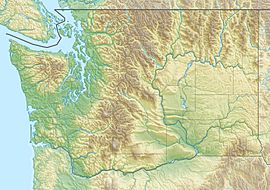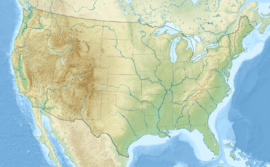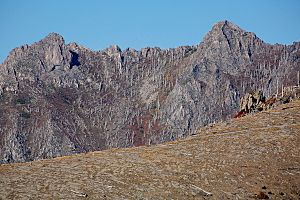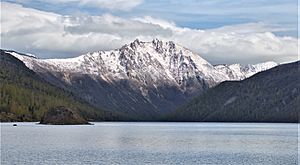Minnie Peak facts for kids
Quick facts for kids Minnie Peak |
|
|---|---|
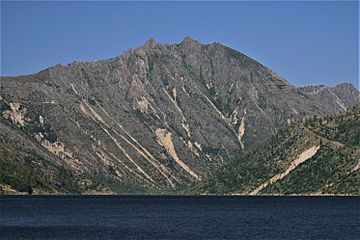
West aspect, from Coldwater Lake
|
|
| Highest point | |
| Elevation | 5,610 ft (1,710 m) |
| Prominence | 890 ft (270 m) |
| Isolation | 1.68 mi (2.70 km) |
| Parent peak | Mount Venus (5,820 ft) |
| Geography | |
| Location | Mount St. Helens National Volcanic Monument Skamania County, Washington, U.S. |
| Parent range | Cascade Range |
| Topo map | USGS Spirit Lake West |
| Geology | |
| Type of rock | granodiorite |
| Volcanic arc | Cascade Volcanic Arc |
| Climbing | |
| Easiest route | scrambling |
Minnie Peak is a mountain that stands 5,610 feet (1,710 meters) tall. It is located in the Mount St. Helens National Volcanic Monument in southwest Washington state. You can find it within the Gifford Pinchot National Forest.
Minnie Peak is part of the Cascade Range. It sits about one mile northeast of Coldwater Lake. It is also 2.7 miles (4.3 km) west of Mount Whittier. The closest taller mountain is Mount Venus, which is 1.67 miles (2.69 km) to the northeast. Coldwater Peak is 2 miles (3.2 km) south, and Mount St. Helens is 9 miles (14 km) south.
Even though Minnie Peak is not super high, it rises very steeply. The summit climbs 3,000 feet from the Coldwater Creek valley in less than a mile. Water from Minnie Peak flows into Coldwater Creek or Miners Creek. Both of these creeks feed into the North Fork Toutle River. The mountain gets its name from the Minnie mining claim nearby. Miners once dug for silver and copper there.
How Minnie Peak Was Formed
The Cascade Range mountains began forming millions of years ago. This happened during a time called the late Eocene Epoch. Over many years, big geological events created the varied landscape we see today. These events caused huge changes in height across the Cascade Range. This also led to different climates in various areas.
About two million years ago, during the Pleistocene period, glaciers moved back and forth. They carved and shaped the land. The North American Plate is slowly moving over the Pacific Plate. This movement caused many volcanic eruptions to happen.
The huge side blast from the 1980 eruption of Mount St. Helens hit Minnie Peak directly. This powerful blast stripped away all the plants from its slopes. Because Mount St. Helens is so close, you can find a lot of volcanic ash in this area. Minnie Peak and Mount Whittier are made of strong rock called granodiorite. This rock comes from the Spirit Lake pluton. A pluton is a mass of once-molten rock that pushed into the surrounding rocks about 20 million years ago.
Weather and Climate
Minnie Peak is in a marine west coast climate zone. This type of climate is found in western North America. Most weather fronts start in the Pacific Ocean. They then travel northeast towards the Cascade Mountains.
As these weather fronts get closer, the peaks of the Cascade Range force them upward. This process is called Orographic lift. When the air rises, it cools and drops its moisture. This means the west side of the Cascades gets a lot of rain or snow. During winter, it is usually cloudy. But in summer, high-pressure systems over the Pacific Ocean often bring clear skies. The best time to visit or climb Minnie Peak is from July through September.


